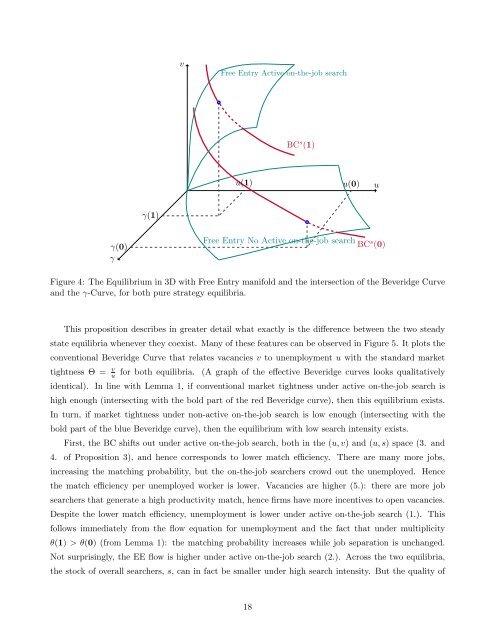Unemployment cycles
WP201526
WP201526
You also want an ePaper? Increase the reach of your titles
YUMPU automatically turns print PDFs into web optimized ePapers that Google loves.
v<br />
Free Entry Active on-the-job search<br />
BC s (1)<br />
u(1)<br />
u(0)<br />
u<br />
γ(1)<br />
γ(0)<br />
γ<br />
Free Entry No Active on-the-job search BC s (0)<br />
Figure 4: The Equilibrium in 3D with Free Entry manifold and the intersection of the Beveridge Curve<br />
and the γ-Curve, for both pure strategy equilibria.<br />
This proposition describes in greater detail what exactly is the difference between the two steady<br />
state equilibria whenever they coexist. Many of these features can be observed in Figure 5. It plots the<br />
conventional Beveridge Curve that relates vacancies v to unemployment u with the standard market<br />
tightness Θ = v u<br />
for both equilibria. (A graph of the effective Beveridge curves looks qualitatively<br />
identical). In line with Lemma 1, if conventional market tightness under active on-the-job search is<br />
high enough (intersecting with the bold part of the red Beveridge curve), then this equilibrium exists.<br />
In turn, if market tightness under non-active on-the-job search is low enough (intersecting with the<br />
bold part of the blue Beveridge curve), then the equilibrium with low search intensity exists.<br />
First, the BC shifts out under active on-the-job search, both in the (u, v) and (u, s) space (3. and<br />
4. of Proposition 3), and hence corresponds to lower match efficiency. There are many more jobs,<br />
increasing the matching probability, but the on-the-job searchers crowd out the unemployed. Hence<br />
the match efficiency per unemployed worker is lower. Vacancies are higher (5.): there are more job<br />
searchers that generate a high productivity match, hence firms have more incentives to open vacancies.<br />
Despite the lower match efficiency, unemployment is lower under active on-the-job search (1.). This<br />
follows immediately from the flow equation for unemployment and the fact that under multiplicity<br />
θ(1) > θ(0) (from Lemma 1): the matching probability increases while job separation is unchanged.<br />
Not surprisingly, the EE flow is higher under active on-the-job search (2.). Across the two equilibria,<br />
the stock of overall searchers, s, can in fact be smaller under high search intensity. But the quality of<br />
18


